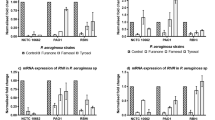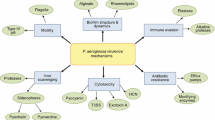Abstract
Bacteria, when adhered to a substratum, can form biofilms. Nevertheless, many factors dictate biofilm formation and virulence factor production, including a response by the bacteria to their surroundings. This system is referred to as Quorum sensing (QS) also known as cell–cell communication. Pseudomonas aeruginosa is an infection causing agent in immune-compromised patients, it uses acyl-homoserine lactone (AHL) to coordinate its QS systems. In this work, the connection between some members of AHL produced by P. aeruginosa PAO1 and its biofilm development and the production of virulence factor was investigated. It was discovered that N-butanoyl-homoserine lactone (C4-HSL) and N-hexanoyl-l-homoserine lactone (C6-HSL) perform a more consequential and eminent function in the biofilm maturation and virulence factor production while N-(3-oxododecanoyl)-l-homoserine lactone (3OC12-HSL) plays a role in biofilm initiation. Because QS has been reported to be required for biofilm development and pathogenesis of P. aeruginosa, the results of this work have great importance and significance for the design of strategies for the control and prevention of biofilms.




Similar content being viewed by others
References
Zhang LH, Dong YH (2004) Quorum sensing and signal interference: diverse implications. Mol Microbiol 53(6):1563–1571
Singh PK, Schaefer AL, Parsek MR, Moninger TO, Welsh MJ, Greenberg EP (2000) Quorum-sensing signals indicate that cystic fibrosis lungs are infected with bacterial biofilms. Nature 407(6805):762–764
Whitehead NA, Barnard AM, Slater H, Simpson NJ, Salmond GP (2001) Quorum-sensing in Gram-negative bacteria. FEMS Microbiol Rev 25(4):365–404
Fuqua C, Parsek MR, Greenberg EP (2001) Regulation of gene expression by cell-to-cell communication: acyl-homoserine lactone quorum sensing. Ann Rev Genet 35(1):439–468
Churchill ME, Sibhatu HM, Uhlson CL (2011) Defining the structure and function of acyl-homoserine lactone autoinducers. In Quorum sensing: methods protocols, Human Press, NewYork, pp 159–171
Gambello MJ, Iglewski BH (1991) Cloning and characterization of the Pseudomonas aeruginosa lasR gene, a transcriptional activator of elastase expression. J Bacteriol 173(9):3000–3009
Ochsner UA, Koch AK, Fiechter A, Reiser J (1994) Isolation and characterization of a regulatory gene affecting rhamnolipid biosurfactant synthesis in Pseudomonas aeruginosa. J Bacteriol 176(7):2044–2054
Passador L, Cook JM, Gambello MJ, Rust L, Iglewski BH (1993) Expression of Pseudomonas aeruginosa virulence genes requires cell-to-cell communication. Science 260(5111):1127–1131
Favre-Bonté S, Köhler T, Van Delden C (2003) Biofilm formation by Pseudomonas aeruginosa: role of the C4-HSL cell-to-cell signal and inhibition by azithromycin. J Antimicrob chemother 52(4):598–604
Davies DG, Parsek MR, Pearson JP, Iglewski BH, Costerton Jt, Greenberg EP (1998) The involvement of cell-to-cell signals in the development of a bacterial biofilm. Science 280(5361):295–298
De Kievit TR, Gillis R, Marx S, Brown C, Iglewski BH (2001) Quorum-sensing genes in Pseudomonas aeruginosa biofilms: their role and expression patterns. Appl Environm Microbiol 67(4):1865–1873
Purevdorj B, Costerton J, Stoodley P (2002) Influence of hydrodynamics and cell signaling on the structure and behavior of Pseudomonas aeruginosa biofilms. Appl Environm Microbiol 68(9):4457–4464
Stoodley P, Jørgensen F, Williams P, Lappin-Scott HM (1999) The role of hydrodynamics and AHL signalling molecules as determinants of the structure of Pseudomonas aeruginosa biofilms. In: Bayston R, Brading M, Gilbert P, Walker J, Wimpenny JWT (eds) Biofilms: the good, the bad, and the ugly. 4th meeting of the Biofilm Club. BioLine, Cardiff, GB
Heydorn A, Ersbøll B, Kato J, Hentzer M, Parsek MR, Tolker-Nielsen T, Givskov M, Molin S (2002) Statistical analysis of Pseudomonas aeruginosa biofilm development: impact of mutations in genes involved in twitching motility, cell-to-cell signaling, and stationary-phase sigma factor expression. Appl Environ Microbiol 68(4):2008–2017
Shrout JD, Chopp DL, Just CL, Hentzer M, Givskov M, Parsek MR (2006) The impact of quorum sensing and swarming motility on Pseudomonas aeruginosa biofilm formation is nutritionally conditional. Mol Microbiol 62(5):1264–1277
Bollinger N, Hassett DJ, Iglewski BH, Costerton JW, McDermott TR (2001) Gene expression in Pseudomonas aeruginosa: evidence of iron override effects on quorum sensing and biofilm-specific gene regulation. J Bacteriol 183(6):1990–1996
Kirisits MJ, Margolis JJ, Purevdorj-Gage BL, Vaughan B, Chopp DL, Stoodley P, Parsek MR (2007) Influence of the hydrodynamic environment on quorum sensing in Pseudomonas aeruginosa biofilms. J Bacteriol 189(22):8357–8360
Davies DG, Parsek MR, Pearson JP, Iglewski BH, Costerton Jt, Greenberg E (1998) The involvement of cell-to-cell signals in the development of a bacterial biofilm. Science 280(5361):295–298
O’toole GA, Kolter R (1998) Flagellar and twitching motility are necessary for Pseudomonas aeruginosa biofilm development. Mol Microbiol 30(2):295–304
Kurachi M (1958) Studies on the biosynthesis of pyocyanine. (II): isolation and determination of pyocyanine. Bull Inst Chem Res Kyoto Univ 36(6):174–187
Genigeorgis C (1995) Biofilm: their significance to cleaning in the meat sector. New challenges in meat hygiene: specific problems in cleaning and disinfection, Ecceamst, European Consortium for Continuing Education. Adv Meat Sci Technol 99:29–47
Shih P-C, Huang C-T (2002) Effects of quorum-sensing deficiency on Pseudomonas aeruginosa biofilm formation and antibiotic resistance. J Antimicrob Chemother 49(2):309–314
Katebian L, Gomez E, Skillman L, Li D, Ho G, Jiang SC (2016) Inhibiting quorum sensing pathways to mitigate seawater desalination RO membrane biofouling. Desalination 393:135–143
Favre-Bonté S, Pache J-C, Robert J, Blanc D, Pechère J-C, van Delden C (2002) Detection of Pseudomonas aeruginosa cell-to-cell signals in lung tissue of cystic fibrosis patients. Microbial Pathog 32(3):143–147
Sauer K, Camper AK, Ehrlich GD, Costerton JW, Davies DG (2002) Pseudomonas aeruginosa displays multiple phenotypes during development as a biofilm. J Bacteriol 184(4):1140–1154
De Kievit T (2009) Quorum sensing in Pseudomonas aeruginosa biofilms. Environm Microbiol 11(2):279–288
Parsek MR, Greenberg E (2005) Sociomicrobiology: the connections between quorum sensing and biofilms. Trends Microbiol 13(1):27–33
Acknowledgements
This research was supported by a Grant (code 18IFIP-B087389-05) from the Industrial Facilities and Infrastructure Research Program funded by the Ministry of Land, Infrastructure, and Transport of Korean government.
Author information
Authors and Affiliations
Corresponding author
Ethics declarations
Conflict of interest
The authors declare no competing financial interest.
Rights and permissions
About this article
Cite this article
Alayande, A.B., Aung, M.M. & Kim, I.S. Correlation Between Quorum Sensing Signal Molecules and Pseudomonas aeruginosa’s Biofilm Development and Virulency. Curr Microbiol 75, 787–793 (2018). https://doi.org/10.1007/s00284-018-1449-5
Received:
Accepted:
Published:
Issue Date:
DOI: https://doi.org/10.1007/s00284-018-1449-5




